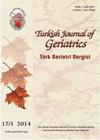PARKINSON'S DISEASE: IS IT ACTUALLY AN INFLAMMATORY DISORDER?
IF 0.3
4区 医学
Q4 GERIATRICS & GERONTOLOGY
Turkish Journal of Geriatrics-Turk Geriatri Dergisi
Pub Date : 2018-12-31
DOI:10.31086/tjgeri.2018.52
引用次数: 3
Abstract
PARKİNSON HASTALIĞI; GERÇEKTE İNFLAMATUAR BİR HASTALIK MI? Introduction: Parkinson’s disease is the second leading neurodegenerative disease worldwide; however, its pathogenesis remains unclear. Recently, the neuroinflammation theory, one of the theories explaining the pathogenesis of Parkinson’s disease, has become prominent. We investigated the relationship between Parkinson’s disease and inflammatory markers including epicardial adipose tissue thickness, neutrophil-lymphocyte ratio, and thrombocyte-lymphocyte ratio. Materials and Method: Seventeen patients with Parkinson’s disease and 21 healthy individuals (control group) were enrolled. All the patients were evaluated by a neurologist using the Unified Parkinson’s Disease Rating Scale and Hoehn and Yahr staging scale. A cardiologist measured epicardial adipose tissue thickness using echocardiography. After routine laboratory analyses, neutrophil-lymphocyte and thrombocyte-lymphocyte ratios were calculated for each patient. Results: Both epicardial adipose tissue thickness and thrombocyte-lymphocyte ratio were higher in the patient group than in the control group, but the difference was significant only for the former. Epicardial adipose tissue thickness was significantly correlated with the scores of 2nd and 3rd sections of the Unified Parkinson’s Disease Rating Scale, which evaluate activities of daily living and motor functions, respectively, and with the total Unified Parkinson’s Disease Rating Scale score. Inflammatory marker evaluation according to the disease stage based on the Hoehn and Yahr staging scale revealed a significant difference in epicardial adipose tissue thickness between stage 1 and stage 2 patients. Moreover, there was a significant correlation between disease duration and thrombocyte-lymphocyte ratio. Conclusion: Our results support the hypothesis that inflammation plays a role in the pathogenesis of Parkinson’s disease.帕金森氏症:它实际上是一种炎症性疾病吗?
公园İNSON HASTALIĞ我;GerÇekte İnflamatuar bİr hastalik mi ?帕金森病是全球第二大神经退行性疾病;然而,其发病机制尚不清楚。近年来,神经炎症理论(neuroinflammation theory)作为帕金森病发病机制的理论之一,得到了广泛关注。我们研究了帕金森病与炎症标志物的关系,包括心外膜脂肪组织厚度、中性粒细胞-淋巴细胞比率和血小板-淋巴细胞比率。材料与方法:选取17例帕金森病患者和21例健康人作为对照组。所有患者均由神经科医生使用统一帕金森病评定量表和Hoehn and Yahr分期量表进行评估。一位心脏病专家用超声心动图测量心外膜脂肪组织厚度。在常规实验室分析后,计算每个患者的中性粒细胞淋巴细胞和血小板淋巴细胞比率。结果:患者组心外膜脂肪组织厚度和血小板淋巴细胞比值均高于对照组,但仅患者组差异有统计学意义。心外膜脂肪组织厚度与统一帕金森病评定量表(统一帕金森病评定量表)第2段和第3段评分(分别评估日常生活活动和运动功能)及统一帕金森病评定量表总分显著相关。根据Hoehn和Yahr分期量表进行疾病分期的炎症标志物评估显示,1期和2期患者心外膜脂肪组织厚度存在显著差异。此外,病程与血小板-淋巴细胞比值有显著相关性。结论:我们的研究结果支持炎症在帕金森病发病机制中起作用的假设。
本文章由计算机程序翻译,如有差异,请以英文原文为准。
求助全文
约1分钟内获得全文
求助全文
来源期刊

Turkish Journal of Geriatrics-Turk Geriatri Dergisi
GERIATRICS & GERONTOLOGY-
CiteScore
0.60
自引率
0.00%
发文量
46
审稿时长
6-12 weeks
期刊介绍:
Turkish Journal of Geriatrics is a peer-reviewed journal. Official language of the journal is English. Turkish Journal of Geriatrics invites submission of Original Articles based on clinical and laboratory studies. Review Articles are published only after the invitation from the Editorial Board.
 求助内容:
求助内容: 应助结果提醒方式:
应助结果提醒方式:


